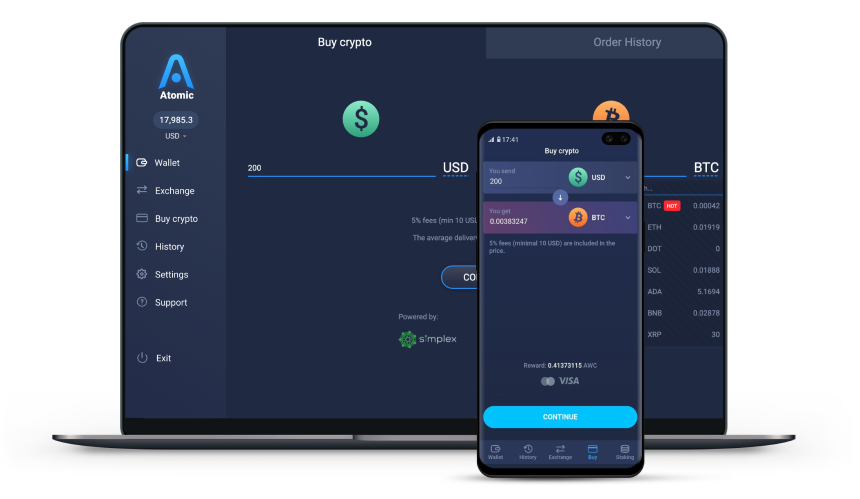Buy Uniswap (UNI) with Credit Card
Buy UNI with a debit or credit card, bank transfer, PayPal, Visa, or Apple Pay – fast and secure, straight into your app.




Buy Uniswap and 20+ Popular Coins in One Place
You can get Bitcoin, Ethereum, USDT, ADA and more than 20+ popular coins instantly with your card, worldwide.
Why Users Are Buying Uniswap Today
Uniswap (UNI) is more than just a token—it’s your key to shaping one of the biggest decentralized exchanges on Ethereum. When you buy UNI, you’re not just investing in DeFi—you’re getting a voice in how it evolves, all while supporting a thriving multi-chain ecosystem.

Governance Power in DeFi
UNI holders can vote on key protocol upgrades, fee structures, and development grants — directly influencing the future of Uniswap and DeFi as a whole.

Decentralized and Trustless Trading
Uniswap enables permissionless token swaps without relying on centralized intermediaries. Users value UNI as part of an open, self-custodial financial system.

Multi-Chain Expansion
With support for Ethereum Layer 2 networks (Arbitrum, Optimism), and non-EVM chains like Polkadot and Cosmos, Uniswap is positioning itself as a cross-chain DeFi hub — boosting demand for its native token.
Payment methods

Buy UNI with Credit/Debit Card
Purchase UNI instantly using your credit or debit card. Atomic supports major providers including Visa – allowing you to buy Uniswap with Visa effortlessly.

Buy UNI with Bank Transfer
Link your bank account to securely buy Uniswap via SEPA or SWIFT. Ideal for European customers and users who prefer traditional payment rails.

Buy UNI with PayPal
Use your PayPal account for a quick and convenient way to buy Uniswap. A great option if you want to pay without entering card details directly.

Buy UNI with Google Pay
For Android users, Google Pay offers a fast and secure option to purchase UNI within seconds, directly from your mobile wallet.

Buy UNI with Apple Pay
Apple Pay makes it easy for iOS users to buy Uniswap in a few taps. Enjoy smooth integration with Face ID and Touch ID for a seamless checkout.
What Our Customers Say

Sophie Delacroix


I’d never bought Uniswap before, but Atomic made it super simple. The whole process took just a few minutes, and my UNI landed in my wallet fast. Definitely coming back next time.

Leo Nakamura


Used Apple Pay to buy Uniswap — fast, smooth, no hassle at all.

Mila Petrovic


Atomic Wallet made everything easy. I expected a bunch of steps, but it was quick, clean, and user-friendly. Got my UNI without any delays.


Swap Instantly & Earn Cashback
Swap supported coins like USDT or ETH inside Atomic Wallet and convert them to Uniswap (UNI) by transferring to an external exchange. While UNI isn’t directly swappable in-app, eligible swaps still offer up to 1% cashback—depending on asset and partner availability.
Swap nowGet Even More Crypto
Expand your portfolio in a few taps. Use your card to access top coins. All in one place.
Buy crypto
FAQ
Got questions about buying Uniswap? Here’s everything you need to know before getting started with Atomic Wallet.
[email protected]What is the easiest way to buy Uniswap (UNI)?
The easiest way to buy Uniswap is through Atomic Wallet. Just install the app, complete a quick ID verification, choose Uniswap from the list, and pay using your preferred method. Your UNI will be delivered to your account in minutes – securely and hassle-free.
Can I buy Uniswap instantly with a credit or debit card?
Yes, Atomic Wallet lets you purchase UNI instantly using your credit or debit card. Visa, Mastercard, and other major providers are supported. It’s one of the fastest and most convenient ways to get started with UNI. Atomic supports major providers including Visa – allowing you to buy Uniswap with Visa effortlessly.
Is it safe to buy Uniswap online through Atomic Wallet?
Absolutely. All purchases are processed through trusted, licensed EU and US payment providers. Your transaction is encrypted, and your funds are sent directly to your wallet. No third-party custody, no compromises!
How long does it take to receive Uniswap after purchase?
Most UNI purchases are completed within 5 to 15 minutes. Processing time depends on your selected payment method, but in most cases, your UNI will arrive almost instantly.
Do I need a wallet to buy and store Uniswap?
Yes, and that’s why the Atomic Wallet is ideal. It automatically creates a secure, non-custodial wallet when you sign up. You retain full control of your UNI from the moment you buy it.
Can I get Uniswap with PayPal, Apple Pay, or Google Pay?
Yes, you can buy Uniswap with PayPal, depending on your region and selected provider. Just choose the method that works best for you at checkout. Apple Pay and Apple Cash are both supported, so you can buy Uniswap with Apple Cash right from your iPhone.
Are there any fees when buying Uniswap through Atomic Wallet?
Yes, third-party providers apply a small processing fee for handling transactions. All fees are shown clearly before confirmation – there are no hidden charges, and you always know what you’ll pay.
What can I do with Uniswap after buying it?
You can hold it, track the price in your wallet, or use it to vote on governance proposals in the Uniswap DAO. UNI isn’t used for staking, but it gives you a voice in one of the biggest DeFi protocols out there.













